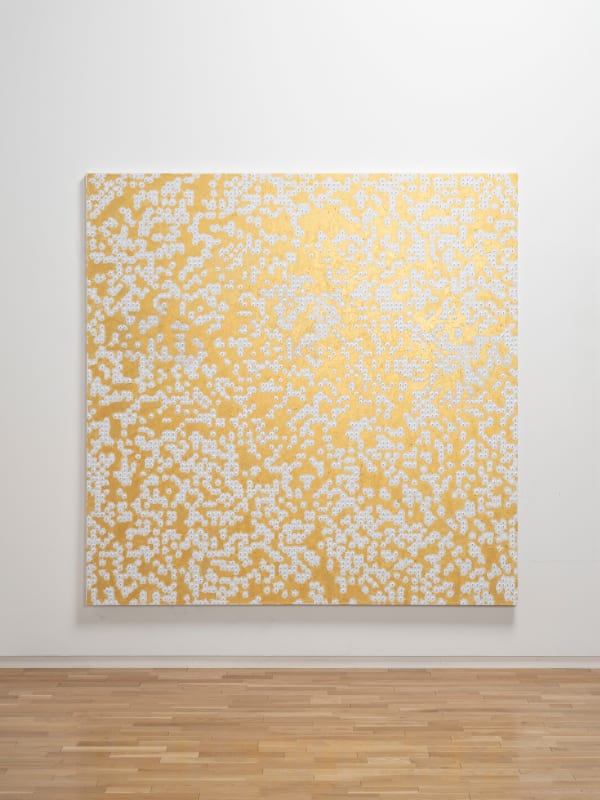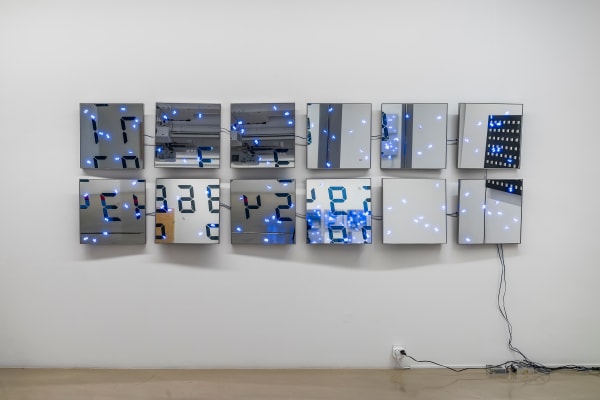Tatsuo Miyajima: Infinite Numeral
Past exhibition
Installation Views
Press release
Gallery Baton is pleased to announce Infinite Numeral, a solo exhibition by the internationally renowned contemporary artist Tatsuo Miyajima (b. 1957). The exhibition opens from 2nd March to 8th April 2023. At his first exhibition at the gallery in 2020, Miyajima showed a chronicle of experimental fusion between LED and other diverse materials appearing throughout his prior works of the 1980s and the recent “Hiten Series.” Besides his signature styles of works with digital LED counters, he will introduce a new painting series titled Beads Painting for the first time in this exhibition.
His representative flickering LED installation in the Japan Pavilion at the 48th Venice Biennale (1999) certainly raised his global recognition. The digital LED counters of his all practice repeat the number from 9 to 1 in descending order at different speeds - except for 0. In this respect, time, the abstract and immaterial concept shifts into the LED units; they stand for independent presences, and the subtle difference of each countdown speed and photochromic trait plays a crucial role in underlining their individuality.
Thus, the physical characteristics of LED efficiently deliver the significant phrase of his philosophy, “It keeps changing, it connects with everything, it continues forever.” By paying attention to the universality of this specific material transcending several periods, yet it is a symbolic production of the Digital era, Miyajima has approached the meta-discourse on ‘the notion of time and its visualization’ in an aesthetical context. As the colony of LED pieces can be a figurative reminder of a society, a generation, or a nation from the semantic point of view, the constantly flickering 2,400 blue LED counters of Mega Death (1999, presented at the 48th Venice Biennale) demonstrate the artist’s perspective towards historical facts or social phenomena.
It takes looking back 30 years ago to figure out how the Beads Painting Series began. When he was immediately fascinated by the numerical beads accidentally found on an outdoor stand in Paris and came across the thought that each tiny marble signified a microcosm, Miyajima decided to visualize a macroscopic universe by arranging a large number of them in the future. Although he studied oil painting at the Tokyo University of the Arts, it took a long time for him to realize the idea since he was preoccupied with the LED series. During the pandemic, he was able to spend time to take various experiments and attempts to produce the visual result that overcomes the gap between his concept and the real.
A two-centimeter square grid unfolds over the plane of the work, and three separate sections occupy its surface arbitrarily, more accurately, according to Miyajima’s sense of spontaneous performance and intuition. They are a first vacant grid, a second grid containing small-size numerical beads, and a third grid whose applied paints have an irregular range of densities. The most intriguing point is that his Beads Paintings successfully convey Miyajima’s authentic exploration of aesthetics, though their visual mechanism differs from how the LEDs function and manifest. The three parts are metaphors of the separate states: Void, On, and Off. Consequently, their combination lets the work attain specific authority as if they were an original blueprint or a prototype of his LED works whose color spectrum continuously changes depending on the electric power shared in the same space.
His representative flickering LED installation in the Japan Pavilion at the 48th Venice Biennale (1999) certainly raised his global recognition. The digital LED counters of his all practice repeat the number from 9 to 1 in descending order at different speeds - except for 0. In this respect, time, the abstract and immaterial concept shifts into the LED units; they stand for independent presences, and the subtle difference of each countdown speed and photochromic trait plays a crucial role in underlining their individuality.
Thus, the physical characteristics of LED efficiently deliver the significant phrase of his philosophy, “It keeps changing, it connects with everything, it continues forever.” By paying attention to the universality of this specific material transcending several periods, yet it is a symbolic production of the Digital era, Miyajima has approached the meta-discourse on ‘the notion of time and its visualization’ in an aesthetical context. As the colony of LED pieces can be a figurative reminder of a society, a generation, or a nation from the semantic point of view, the constantly flickering 2,400 blue LED counters of Mega Death (1999, presented at the 48th Venice Biennale) demonstrate the artist’s perspective towards historical facts or social phenomena.
It takes looking back 30 years ago to figure out how the Beads Painting Series began. When he was immediately fascinated by the numerical beads accidentally found on an outdoor stand in Paris and came across the thought that each tiny marble signified a microcosm, Miyajima decided to visualize a macroscopic universe by arranging a large number of them in the future. Although he studied oil painting at the Tokyo University of the Arts, it took a long time for him to realize the idea since he was preoccupied with the LED series. During the pandemic, he was able to spend time to take various experiments and attempts to produce the visual result that overcomes the gap between his concept and the real.
A two-centimeter square grid unfolds over the plane of the work, and three separate sections occupy its surface arbitrarily, more accurately, according to Miyajima’s sense of spontaneous performance and intuition. They are a first vacant grid, a second grid containing small-size numerical beads, and a third grid whose applied paints have an irregular range of densities. The most intriguing point is that his Beads Paintings successfully convey Miyajima’s authentic exploration of aesthetics, though their visual mechanism differs from how the LEDs function and manifest. The three parts are metaphors of the separate states: Void, On, and Off. Consequently, their combination lets the work attain specific authority as if they were an original blueprint or a prototype of his LED works whose color spectrum continuously changes depending on the electric power shared in the same space.
Video
Works







